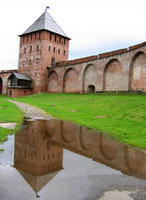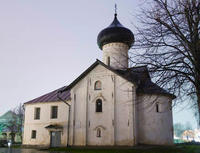You are in: Europe -> Russia -> Historic Monuments o... , and traditional search or Image Gallery will yield results of this site only
Historic Monuments of Novgorod and Surroundings
| Site number: | 604 |
|
| Type of site: | Cultural | |
| Date: | 9th century | |
| Date of Inscription: | 1992 | |
| Location: | Eurasia, Russian Federation, Novgorod Oblast | |
Up to 75 images are shown here. Click on each for more details or on Image Gallery for more images.
Six official UN languages:
Arabic,
Chinese,
English,
French,
Russian,
Spanish
Other languages: Czech, Danish, Dutch, Esperanto, Finnish, German, Hebrew, Hungarian, Italian, Japanese, Latin, Latvian, Lithuanian, Norwegian-bokmål, Norwegian-nynorsk, Polish, Romanian, Serbian, Swedish, Vietnamese, Welsh
Other languages: Czech, Danish, Dutch, Esperanto, Finnish, German, Hebrew, Hungarian, Italian, Japanese, Latin, Latvian, Lithuanian, Norwegian-bokmål, Norwegian-nynorsk, Polish, Romanian, Serbian, Swedish, Vietnamese, Welsh
| Description: | Novgorod, sitting on the ancient trade route connecting Central Asia and northern Europe, was the first capital of Russia in the 9th century. Enclosed by churches and monasteries, it was the heart of Orthodox spirituality in addition to Russian architecture. Demonstrating the development of its incredible architecture and cultural creativity are its medieval monuments and the 14th-century frescoes of Theophanes the Greek-Andrei Rublev's teacher. --WHMNet paraphrase from the description at WHC Site, where additional information is available. | |
| Veliky Novgorod (Russian: Вели́кий Но́вгород) is the foremost historic city of North-Western Russia, the administrative center of Novgorod Oblast. It is situated on the M10 federal highway connecting Moscow and St. Petersburg. "Novgorod" is the Russian word for "new city", whereas "Veliky" means "the Great". The city lies along the Volkhov River just below its outflow from Lake Ilmen. Notwithstanding its name, Novgorod is among the most ancient cities among the Eastern Slavs. The Sofia First Chronicle first mentions it in 859; the Novgorodian First Chronicle mentions it first under the year 862 when it was allegedly already a major station on the trade route from the Baltics to Byzantium. Archaeological excavations in the middle to late twentieth century, however, have found cultural layers dating back only to the late tenth century, the time of the Christianization of Rus and a century after it was allegedly founded, suggesting that the chronicle entries mentioning Novgorod in the 850s or 860s are later interpolations. No other Russian or Ukrainian city can compete with Novgorod in the variety and age of its medieval monuments. The foremost among these is the St Sophia Cathedral, built between 1045 and 1050 under the patronage of Vladimir Yaroslavich, the son of Yaroslav the Wise (Vladimir is buried in the cathedral along with his mother, Anna.)It is the best preserved of 11th century churches, probably the oldest structure still in use in Russia and the first one to represent original features of Russian architecture (austere stone walls, five helmet-like cupolas). Its frescoes were painted in the 12th century originally on the orders of Bishop Nikita (died 1108) (the "porches" or side chapels were painted in 1144 under Archbishop Nifont) and renovated several times over the centuries, most recently in the nineteenth century. The Novgorod Kremlin, traditionally known as the Detinets, also contains the oldest palace in Russia (the so-called Chamber of the Facets, 1433), which served as the main meeting hall of the archbishops; the oldest Russian bell tower (mid-15th cent.), and the oldest Russian clock tower (1673). The Palace of Facets, the bell tower, and the clock tower were originally built on the orders of Archbishop Evfimii II, although the clock tower collapsed in the seventeenth century and had to be rebuilt and much of the palace of Evfimii II is no longer extant. Among later structures, the most remarkable are a royal palace (1771) and a bronze monument to the Millennium of Russia, representing the most important figures from the country's history (unveiled in 1862). --Wikipedia. Text is available under the Creative Commons Attribution-ShareAlike License. | ||
| Source: | http://whc.unesco.org/en/list/604 | |
| Reference: | 1. UNESCO World Heritage Center, Site Page. | |




